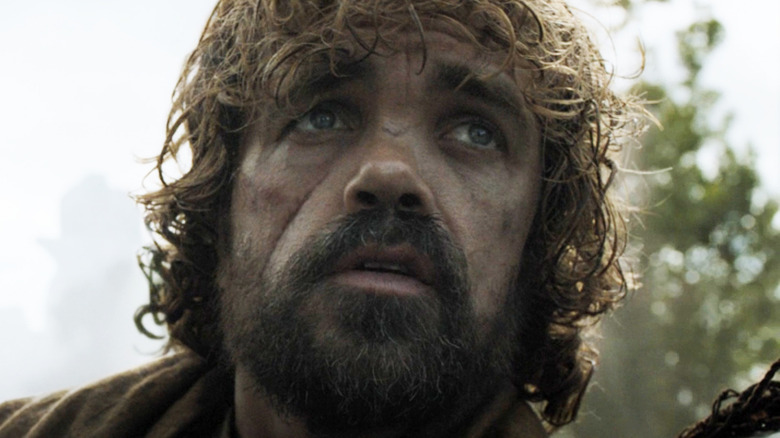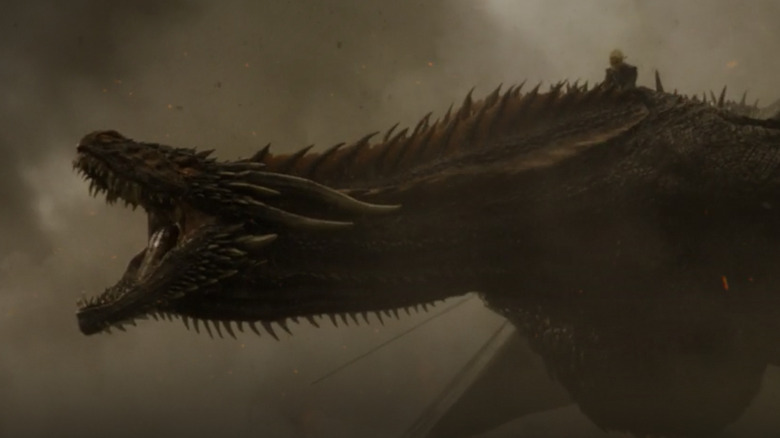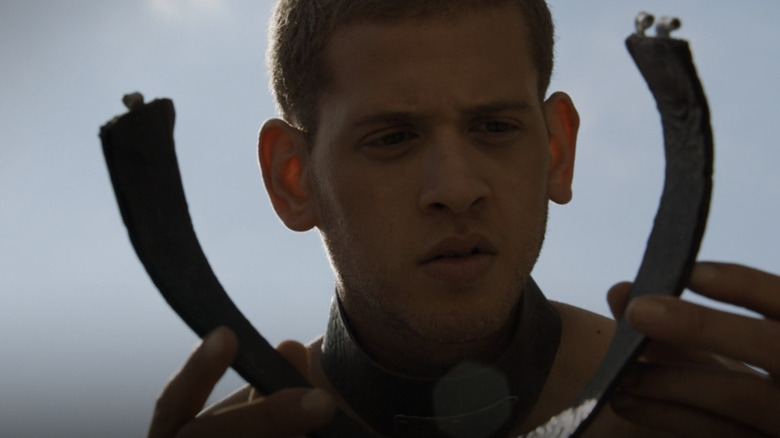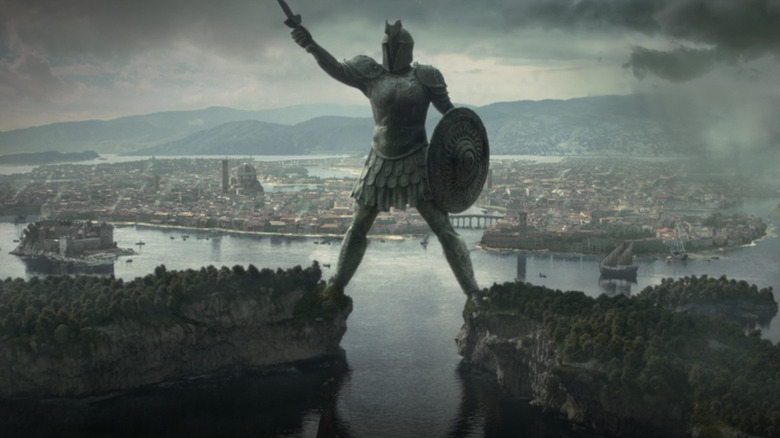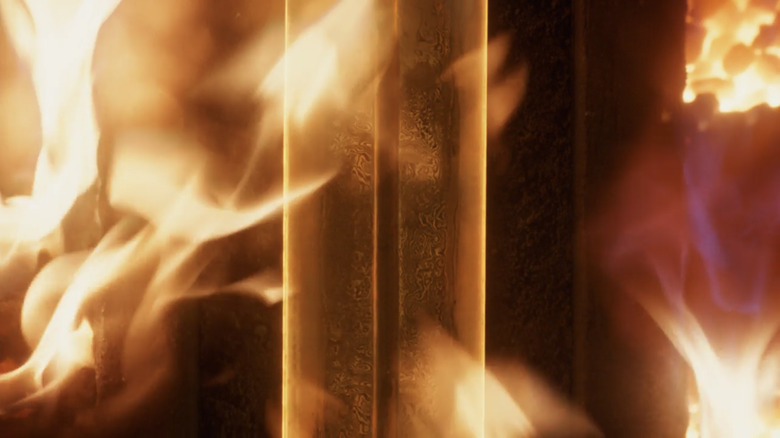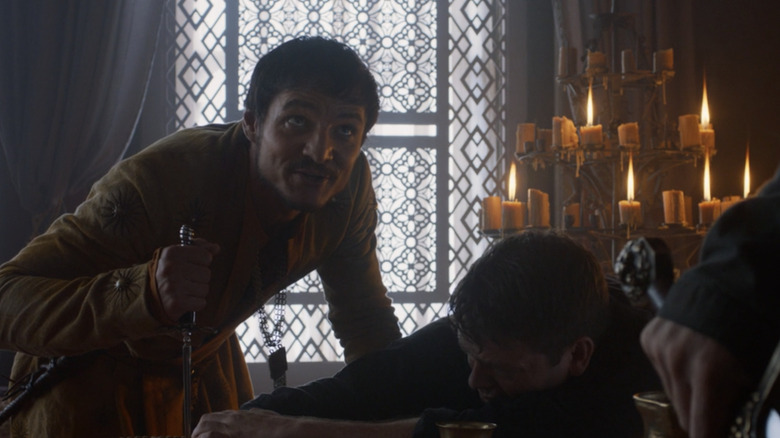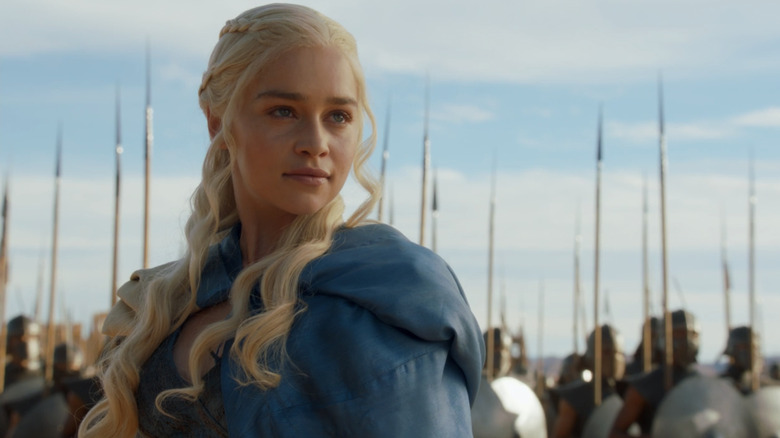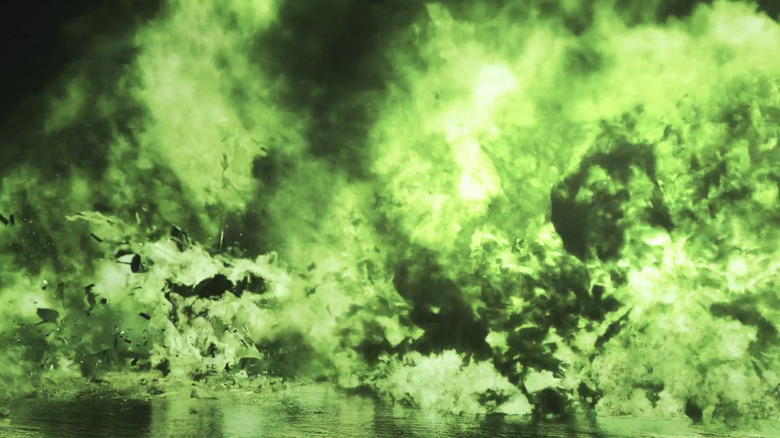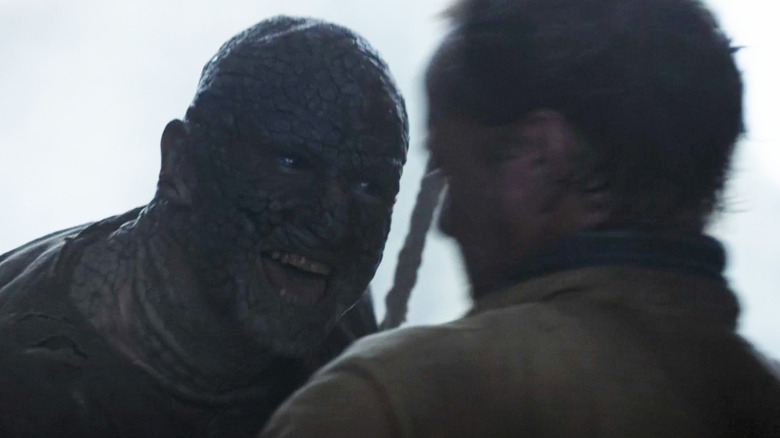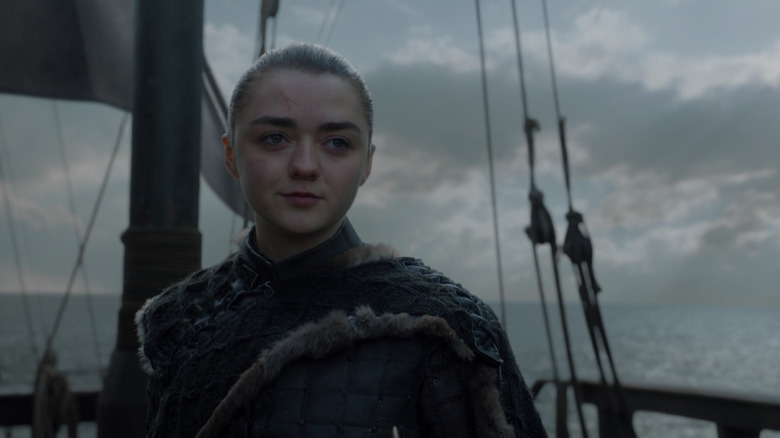The Untold Truth Of Valyria From The Game Of Thrones Universe
There are a million secrets still hidden in the world of HBO's "Game of Thrones" and its source material, George R.R. Martin's "A Song of Ice and Fire" novels. The books remain unfinished, and the show blazes its own trail, ultimately refusing to answer several questions hinted at in early seasons. Even 2014's "The World of Ice and Fire," a massive tome of information detailing the histories of Westeros, Essos, and the lands beyond, plays it coy in several places. Though this might frustrate fans, it also makes sense: Surely many reveals are still to come in future books, which Martin doesn't want to prematurely spoil.
One thing that encyclopedic text does shine some light on, however, is Valyria, the ancient, fallen kingdom that was the original home of House Targaryen. While we might not ever see Valyria at the height of its glory on screen, there's no shortage of Valyria-adjacent content on the way, especially in HBO's richly detailed and Targaryen-centric "House of the Dragon" series. With that in mind, let's explore the untold truth of Valyria — once the greatest civilization in the history of the "Game of Thrones" universe, now a smoking, abandoned ruin.
Valyria was born from dragons
Even with "The World of Ice and Fire" to draw upon, little is known about the beginnings of the Valyrian Freehold. What is known, however, is the thing that made it possible: The Valyrians had dragons. Supposedly, there were dragons all over the world in ancient times, though the Valyrians claimed they were indigenous to their lands. Regardless of that claim's veracity, the Valyrians were the only ones who knew how to tame them, ride them, and use them for purposes of war and conquest.
The city of Valyria occupied a massive peninsula close to Slaver's Bay, home to the slave cities Daenerys Targaryen conquers thousands of years later. Its major geographical feature seems to have been a cluster of volcanic mountains known as the Fourteen Flames, which fits well with the dragon imagery. According to the Valyrians, dragons were first born from the Fourteen Flames. Again, there's no way to verify this, nor do we know the specific techniques the Valyrians used to gain dominance over dragons. All we know for sure is that the Valyrians learned how to control dragons, and the rest of the world did not.
It was a republic that ran on slavery
Many of the nations and histories of George R.R. Martin's world are based on those of the real world. The conflict between the Starks and Lannisters, for example, is generally agreed to be based on the War of the Roses, which was fought between the Yorks and the Lancasters. Valyria is likely no exception, with many fans believing it to be inspired by ancient Rome. Beyond the vastness of both empires, the central argument for this comparison is Martin's description of Valyria as a "Freehold," in which "all the citizenry who held land had a voice." The Valyrians occasionally saw fit to elect temporary leaders, but there were no kings. Rather, a collection of 40 noble families vied for power and influence over Valyria, similar to the Roman patricians.
The Valyrians also echo the ancient Romans in their dependence on slavery. The empire of Ghis, the first victim in Valyria's rise to dominance, was known far and wide for its slaves — hence the name Slaver's Bay, where the last Ghiscari cities linger. This did not protect them, however: Its citizens became the first Valyrian slaves. Indeed, it was the need for more and more slaves to do the dangerous work of mining the Fourteen Flames that drove Valyria's expansion.
Valyria grew into a vast empire
Old Ghis was supposedly one of the first major civilizations of Essos, and was certainly one of its first empires. At its height, however, the Valyrian Freehold dwarfed Old Ghis in size. After conquering the Ghiscari, the need for slaves drove the Valyrians to expand west and north. Few records remain of the various nations and peoples who fell before the dragonriders, but the legacy of Valryian conquest still exists in the form of the nine Free Cities. Each of the Free Cities was either founded by the Valyrians themselves, or as a response to their expansion. For example, Braavos, where Arya Stark trains to be an assassin, was founded by slaves who managed to escape the Freehold's grasp.
As "The World of Ice and Fire" puts it, after defeating the last of their challengers on the continent, "Valyria soon achieved complete domination of the western half of Essos, from the Narrow Sea to Slaver's Bay, and from the Summer Sea to the Shivering Sea." If you consult a map of Martin's world, you can see just how enormous the Freehold had become — it was just about the same size as the Seven Kingdoms of Westeros.
It's the source of Valyrian steel
In "Game of Thrones," the word "Valyrian" is heard most often in the context of "Valyrian steel." This is because anything made from Valyrian steel is highly prized. The very first chapter of the first book details Valyrian steel swords' fine quality: "Nothing held an edge like Valyrian steel." Though existing Valryian steel can be melted down and re-forged, the art of creating it has been lost to history. It seems to have involved "folding iron many times to balance and remove impurities." As a result, Valyrian steel blades are easily identified by the distinctive patterns continual folding has left in the metal. This quality, as well as the notion that the techniques to make it have been lost, seems to be a reference to Damascus steel. The Valyrians are also said to have enhanced the metal with spells, though their details are entirely unknown.
As many as 227 Valyrian steel weapons are said to exist, or have existed, in the Seven Kingdoms. They are traditionally the ancestral weapons of noble houses: Ice is the hereditary blade of House Stark, for example, while Longclaw is the sword of House Mormont, before it's given to Jon Snow. Some Valryian steel swords have been lost to history entirely — Brightroar, which once belonged to House Lannister, vanished alongside King Tommen II on his doomed journey to the ruins of Valyria.
Valyria shaped the Seven Kingdoms
The king of Westeros is traditionally styled as "King of the Andals, the Rhoynar, and the First Men." The First Men, while not Westerosi natives, arrived on the continent long before the rise of Valyria. The Andals and the Rhoynar, however, came as refugees, fleeing the oncoming Valyrian tide. The Andals had previously settled in the land known as Andalos in the northwest corner of Essos, while the Rhoynar came from a vast and beautiful civilization along the river Rhoyne. Eventually, the Valyrian Freehold surged westward and butted up against the Rhoyne. For a time, there was peace between the two peoples. But as the years marched on, the Valyrians' desire for expansion grew more and more insatiable, and war eventually began.
The Andals were the first to flee the Valyrians. They crossed the Narrow Sea, where they proceeded to take Westeros from the First Men by force, establishing what we know as the Seven Kingdoms and introducing the religion of the Seven. The Rhoynar, in contrast, fought to the bitter end, and ultimately lost everything. The sole exception was Princess Nymeria of Ny Sar, who fled with her remaining people on 10,000 legendary ships. Eventually, they arrived in Dorne, whose citizens are still known for their Rhoynish blood and indomitable spirit.
It was the Targaryens' homeland
House Targaryen is the link between the fallen Valyrian Freehold and the events of "Game of Thrones." Originally, the Targaryens were minor Valyrian nobility. Though they were pure-blooded dragonlords, having followed the Valyrian custom of martial incest for centuries, they were not considered especially powerful among the Freehold's 40 ruling families. When Lord Aenar Targaryen's daughter, Daenys the Dreamer, had a vision of Valyria's destruction, the family left the Freehold and settled permanently on the island of Dragonstone, an outpost on the western edge of the empire. Lord Aenar's actions were considered cowardly by his noble Valyrian peers, but history vindicated him: Daenys' dream came true 12 years later as the legendary Doom of Valyria. In the Doom's aftermath, the Targaryens were the only Valyrian house left standing.
Even then, it would be another century before Aegon Targaryen and his sisters, Rhaenys and Visenya, unleashed their dragons upon the Seven Kingdoms, establishing a dynasty that would last for 300 years. While the ending of the books has yet to be written, the end of "Game of Thrones" sees the last Targaryen, and thus the last true Valyrian, wandering happily beyond the Wall — a fate absolutely nobody could have foreseen at the Freehold's height.
Valyria's destruction remains mysterious
We still don't know exactly what happened to Valyria. It was there, vast and beautiful, and then it was gone, destroyed by the mysterious Doom of Valyria. Most likely, the Doom was a natural disaster: The Fourteen Flames are said to have simultaneously erupted during the Doom. Other, more mystical causes have also been floated. Some Septons believe the Doom was the work of the gods, who sought to punish the Valyrians for their hubris and incestuous ways. Other think the sudden failure of some great spell the Valyrians used to keep the Fourteen Flames under control is to blame. The red god, Rh'llor, has been invoked by some, as has the curse of Garin the Great, the Rhoynish king who famously prophesied the Freehold's ruin. Daenys the Dreamer, who foretold the cataclysm, only said that Valyria would be destroyed "by fire." Indeed, "it [is] written that every hill for five hundred miles split asunder to fill the air with ash and smoke and fire so hot and hungry that even the dragons in the sky were engulfed and consumed."
Regardless of what actually happened, the disaster stands as the single most impactful event in this world's history. It plunged Essos into blood and chaos, set the Targaryen conquest in motion, and literally reshaped the planet. Centuries later, the ruins of Valyria still smoke, home to nightmares beyond imagination.
The ruins are infested by Stone Men
For the most part, there is no functional difference between the books' portrayal of Valyria and that of "Game of Thrones." There is, however, one major divergence between the two. In the Season 5 episode "Kill the Boy," Jorah Mormont and Tyrion Lannister actually pass through the ruins of Valyria on their way to meet Daenerys Targaryen. They are soon attacked by "Stone Men," wretched creatures who carry a deadly and disfiguring disease called greyscale. Mormont contracts the disease as a result of the attack, though he is later cured.
None of this happens in the books, though something similar does. Daenerys might not actually be the last Targaryen — her nephew, Aegon, is revealed to still be alive, though many fans believe he's a pretender. He is protected by a knight named Jon Connington. In the books, it is Connington who contracts greyscale while protecting Tyrion. Moreover, this happens as they travel down the Rhoyne, not through Valyria — here, greyscale is said to be a product of Garin's curse. But of course, this entire plot thread does not exist in "Game of Thrones." Instead, we catch an enigmatic glimpse of Valyrian ruins, and the tragic figures who occupy them.
Nobody who's been there has returned
The sight of Jorah and Tyrion taking a jaunt through Valyria is jarring to book fans — and not just because it repurposes someone else's storyline. In the books, nobody goes to Valyria. Those who try are either never seen again, or return to Westeros and promptly die in terrifying agony.
Immediately after the Doom, a surviving dragonlord named Aurion declared himself Emperor of Valyria. He took his dragon and men to his smoking homeland, and promptly vanished. Years later, King Tommen Lannister II assembled a vast fleet to sail to Valyria and plunder its abandoned riches. He never returned. Later still, Gerion Lannister, Lord Tywin's younger brother, set out to retrieve Brightroar, the Valyrian steel sword Tommen took with him. Gerion, too, was apparently lost forever.
The horrifying story of Princess Aerea Targaryen offers a glimpse into what might have happened to these would-be explorers. In the early days of the dynasty, she disappeared for over a year on the back of Balerion, the dragon Aegon I once rode. She returned to Westeros on the verge of death. The horrors found inside her body led those who observed her final moments to believe that Balerion took her to the ruins of Valyria. Travel there was henceforth forbidden, though this law has supposedly been broken by Euron Greyjoy, who claims to have seen Valyria with his own eyes.
